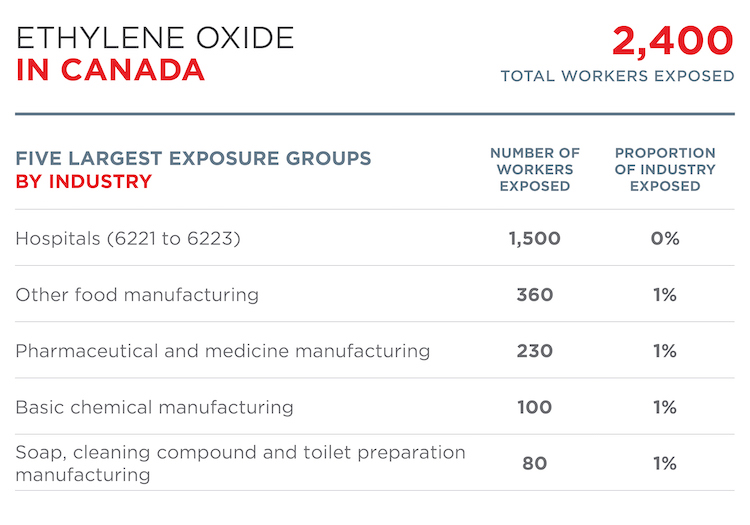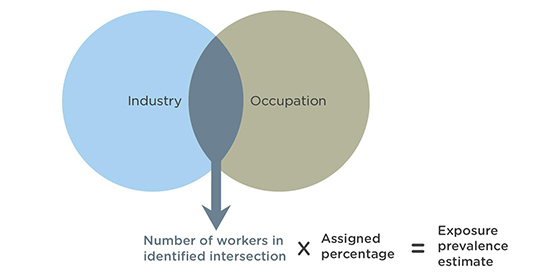Ethylene Oxide Occupational Exposures
Ethylene Oxide Occupational Exposures
Overview
Inhalation is the most important route of occupational exposure to ethylene oxide.[1] Although the majority of ethylene oxide is used to produce chemicals, most occupational exposure occurs through its use in sterilization, particularly of medical equipment.[2,3] The highest exposures have been measured in facilities using EtO as a sterilant or fumigant, including hospitals, healthcare facilities, and spice manufacturers.[4]
READ MORE...
Workers may be exposed while changing ethylene oxide gas cylinders; from leaking equipment; from improper ventilation at the sterilizer door, discharge line, aerators, and in the general room; during removal and transfer of items from the sterilizer to an aerator; and from incomplete aeration of items.[2] Ethylene oxide is registered for use as a disinfectant in six products listed in the Drug Products Database of Health Canada.[5] Some studies show that exposures during sterilization procedures can be effectively controlled by industrial hygiene measures.[2] Current average concentrations of ethylene oxide in hospitals and production facilities have decreased substantially from historical levels, to <2 mg/m3 in western Europe and North America.[2]
There is potential for exposure to EtO during production of industrial chemicals. However, these processes are usually automated and contained in closed systems, which minimizes exposure.[4] Exposures in the chemical industry occur mainly during loading and unloading of transport tanks, product sampling, and equipment maintenance and repair.[6]
Prevalence Estimate
Results indicate that approximately 2,400 Canadians are occupationally exposed to ethylene oxide; 62% of these workers are female. The industries with the largest number of exposed workers include hospitals, food manufacturing (where ethylene oxide is used as a sterilizing agent), pharmaceutical and medicine manufacturing, and in basic chemical manufacturing where it is used as a chemical intermediate.
When exposure is examined by occupation, the largest exposed groups are nurse aides, orderlies and patient service associates (1,100 workers exposed), other assisting occupations in support of health services (410 workers exposed), and process control and machine operators in food and beverage processing (100 workers exposed).
The number of workers exposed to ethylene oxide remained approximately the same from 2006 to 2016. However, changes were observed by industry, with the overall number of workers in healthcare and manufacturing increasing, and the number of workers in manufacturing decreasing.
Workers exposed to ethylene oxide by industry in 2016

Workers exposed to ethylene oxide by region in 2016
Click the second tab to view total number of workers exposed.
* = < 50 workers
Level of Exposure
In total, approximately 2,400 Canadians are exposed to ethylene oxide in their workplaces. The majority of workers exposed to ethylene oxide are in the moderate exposure category.
Workers exposed to ethylene oxide by exposure level in 2016
Level of exposure by industry
Identifying industries with either: 1) workers exposed to high levels of ethylene oxide or 2) a larger number of workers exposed to ethylene oxide is important in guiding cancer prevention efforts to prioritize exposed groups and target resources most effectively.
The table below shows workers exposed by industry, occupation and level of exposure to ethylene oxide for industries with greater than 80 exposed workers. These results highlight industries with the greatest number of workers, as well as varying levels of exposure between occupational groups. Hospital settings account for over 60% of exposed workers. Nursing assistants compose the majority of workers exposed to ethylene oxide in hospital sterile processing, while sterilization technicians are most highly exposed. In other sterilization (e.g. pharmaceutical and medicine manufacturing; other food manufacturing) and chemical production industries (e.g. basic chemical manufacturing and soap, cleaning compound and toilet preparation manufacturing), labourers and maintenance workers are most highly exposed; information about proportions of workers in each job group is currently unavailable.
Depending on the goals of a prevention campaign, exposure reduction in the large occupational group might be a useful strategy, or reducing exposure to those at highest risk of exposure could be seen as a priority.
Workers exposed to ethylene oxide by exposure level and industry in 2016
*Numbers may not add up due to rounding
Methods and Data
Our Occupational Approach page outlines the general approach used to calculate prevalence and exposure level estimates for workplace exposures.
Data Sources
Data used in developing the occupational estimates for ethylene oxide were collected from several sources:
- The Canadian Workplace Exposure Database (CWED) contains over 1,400 measurements for ethylene oxide exposure. These measurements were collected during the years 1981 to 2004 in Ontario and British Columbia workplaces;
- A provincial hospital human resources database with occupation-specific demographics and practice areas;
- Canadian and US scientific peer reviewed publications that address ethylene oxide exposure in Canada and the United States; and
- Grey literature including technical reports from governments, industries, and international bodies.
Prevalence Estimate Method
CAREX defines exposure to ethylene oxide as inhalation and/or dermal exposure at work, at levels exceeding those encountered in the general environment.
To determine the number of workers potentially exposed to ethylene oxide at work, CAREX occupational exposure experts used methods previously established in other peer-reviewed CAREX projects in Europe. A series of steps were taken to assign exposure proportions to occupations and industries at risk of exposure to ethylene oxide.

- Occupations and industries at risk of possible exposure to ethylene oxide were identified using any combination of data sources described above.
- The total number of workers in each identified occupation and industry intersection was obtained from Statistics Canada 2016 census data.
- A percentage of workers exposed was assigned to that occupation and industry intersection. Percentages were determined by consultation with existing evidence in the data sources, previously established methods from the Europe CAREX estimates and the expert judgement of CAREX occupational hygienists.
- The number of workers in the identified group is multiplied by the assigned percentage to calculate the prevalence estimate of workers exposed to ethylene oxide.
Exposure Level Method
CAREX used available workplace exposure measurements in the CWED and tailored methods to create relative exposure level categories by industry and occupation. For ethylene oxide, these categories are:
Category 1: Low Exposure
A group of workers (people in the same job category) is put in this exposure category if CWED measurements, and review of literature and industry/government reports indicate that exposure to ethylene oxide is minimal.
Category 2: Moderate Exposure
A group of workers is put in this exposure category if:
- CWED measurements indicate some degree of historical exposure, AND/OR
- Review of literature and reports indicates that job tasks may currently be associated with low to moderate levels of exposure.
Category 3: High Exposure
A group of workers is put in this exposure category if:
- CWED measurements indicate high levels of historical exposure, AND/OR
- Review of literature and reports indicates that job tasks may currently be associated with high levels of exposure.
Sources
Subscribe to our newsletters
The CAREX Canada team offers two regular newsletters: the biannual e-Bulletin summarizing information on upcoming webinars, new publications, and updates to estimates and tools; and the monthly Carcinogens in the News, a digest of media articles, government reports, and academic literature related to the carcinogens we’ve classified as important for surveillance in Canada. Sign up for one or both of these newsletters below.
CAREX Canada
School of Population and Public Health
University of British Columbia
Vancouver Campus
370A - 2206 East Mall
Vancouver, BC V6T 1Z3
CANADA
As a national organization, our work extends across borders into many Indigenous lands throughout Canada. We gratefully acknowledge that our host institution, the University of British Columbia Point Grey campus, is located on the traditional, ancestral, and unceded territories of the xʷməθkʷəy̓əm (Musqueam) people.



